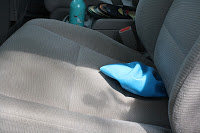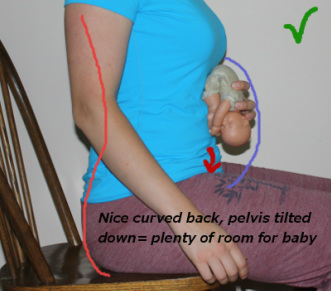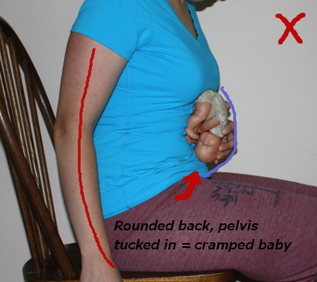Car seats are particularly poorly made for good alignment, which is extra important in pregnancy to give the baby plenty of room. Avoid lengthy car rides as much as possible. For best body mechanics, posture, and core strength, whether pregnant or not, follow these steps to a better car seat.
Step 2. If it’s a feature on your car, adjust the front of the seat (where your thighs are) so that it is parallel to the floor, or as parallel as you can get it. When sitting in the seat, you want your knees on level with your hips or below your hips, not above so that your butt is wedged in a little nest. While taking pictures for this post, I discovered that there are, incredibly, five different ways the driver’s seat of my mini-van can be adjusted. You can help your alignment a lot by adjusting these.Step 3. Undo the butt-in-bucket effect of the car’s bucket seat. Place a folded towel in the space to make the seat more even and parallel to the floor. Even when you have adjusted in steps one and two, you will see a little butt crevice that is supposed to be comfy. It is comfy, but it’s not good. The seat looks somewhat like a check mark. Sitting for long periods in a check mark is a good way to get a breech or posterior baby. It’s also a good way to mess up your natural body alignment, weaken your core, and cause yourself chronic discomfort.
How to fold a towel wedge for the butt crevice in the car or elsewhere.
 Looks sexy, huh? The ‘gooier’ the ball material, the better!
Looks sexy, huh? The ‘gooier’ the ball material, the better!
You can also use a slo-mo or other kid’s ball that has all but a small amount of air removed. Place this mostly deflated ball between your butt bones to help raise you up and tilt your pelvis. I think this feels good when sitting on a bench or kitchen chair as well.
1. Knees at or below level of hips?
2. Pelvis tilted down slightly, into the seat?
3. Small of back curved in, not rounded out?
4. Shoulders back, two hands on wheel for symmetry and balance?
5. Rib cage down? Core engaged?A good test for #2 and #3 is as follows: Rock side to side a bit to feel the butt bones you’re sitting on. Feel ’em? Now tilt your pelvis forward slightly– the small of your back will curve in nicely, sticking your belly out. Great for your body and your baby.
Sitting in chairs
Midwives who work among the Amish have noted a significant increase in the incidence of breech since the Amish community switched from traditional wooden chairs to sofas and recliners. As you can imagine, they generally don’t spend much time in cars. When you can, avoid sofas, recliners, and other lounge chairs. Pretend you are in a Jane Austen novel.
How to sit:
2. Knees at or below level of hips. You see why a habitually cramped baby might stay breech to give his head a bit more room up top.
4. Small of back curved in, not rounded out?
5. Rib cage down? Core engaged?Alternative sitting ideas:
- Use a kitchen chair, but sit on it backwards, leaning on the back. This is excellent for creating a nice belly hammock for your baby, which helps her get into the best position for birth.
- Use a Swedish chair.
- Sit on a well-inflated exercise ball. Keep your feet apart and make sure your knees are apart, belly between your legs.
- Tailor sitting on the floor. Use blankets or towels under butt and ankles as necessary.
Relaxing
When you can, instead of sitting on the couch or recliner, when you want to relax, just lay down. There are a number of good pillow and cushion arrangements to support your back and belly as you lay on your side.






